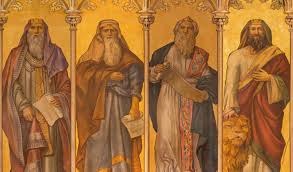Today is 21 December, the Winter Solstice and the Feast of the Old Testament Prophet St. Micah.
 Since the beginning of December, Holy Mother Church has been imitating the Lord on the Road to Emmaus.
Since the beginning of December, Holy Mother Church has been imitating the Lord on the Road to Emmaus.
She has been reminding us of all the prophecies about the coming of the Messiah who would also be incarnate God.
She has done this subtly, through feast days, but feasts that are not generally visible to most of us. Holy Mother Church has used her “album of the saints”, the Roman Martyrology, to teach about the Old Testament Prophets.
Sometimes you hear people – even priests, for shame – use the word “liturgy” when they mean “Mass”. “In today’s ‘liturgy’…”, they say.
No. The Mass is the greatest expression of the Church’s liturgy, but it is not all there is. There are also the canonical hours of the divine Office. The Office also makes use of the liturgical book called the Roman Martyrology.
Paging through the 2005 Martyrology, we find that many Old Testament figures are counted as saints.
If the general calendar of the Church permits, it would even be possible to celebrate them for Mass!
Today, for example, is the Winter Solstice AND the Feast of St. Micah. Micah said (5:2)
But you, O Bethlehem Eph?rathah,
who are little to be among the clans of Judah,
from you shall come forth for me
one who is to be ruler in Israel,
whose origin is from of old,
from ancient days.
About those Old Testament prophets…
Keep in mind that in earlier days, Advent was longer than it is now, from Martinmas. Prophets start popping up in the calendar in the 2005 Martyrology.
19 Nov – Abdia or Obediah. (RomMart 2005, p. 632)
1 Dec – Nahum (p. 652)
2 Dec – Habakkuk (p. 654)
3 Dec – Sophonius or Zephaniah (p. 655)
16 Dec – Haggai (p. 674) and some sources David (others have David on 29 Dec)
18 Dec – Malachi (p. 677)
21 Dec – Micah (p. 680)
24 Dec – “Commemoratio omnium sanctorum avorum Iesu Christi, filii, David, filii Abraham, filii Adam…” (p. 684) Commemoration of all the holy “ancestors” (lit. grandfathers) of Jesus Christ, son of David, son of Abraham, son of Adam
Just a little public service announcement.
FYI… other prophets
1 May – Jeremiah (p. 263)
9 May – Isaiah (p. 277)
15 June – Amos (p. 338)
20 July – Elijah (p. 401)
21 July – Daniel (1878 MartRom)
23 July – Ezekiel (p. 408)
4 Sept – Moses (1878 MartRom)
6 Sept – Zachariah (1878 MartRom)
21 Sept – Jonah (p. 528)
17 Oct – Hosea (p. 575)
19 Oct – Joel (p. 579)


































Christians do ourselves and the world to whom we are tasked to evangelize a disservice when we neglect the Hebrew scriptures.
In particular, most of the prophetic books were written after the death of Solomon and subsequent rending of the Kingdoms of Israel and Judah. It was during these periods of the divided kingdom, Babylonian exile, return to the Promised Land, and Maccabean Revolt that the Jewish nation was made ready to receive her Messiah.
The Carmelites keep Eliseus/Elisha the prophet “Pater Noster”) on 14 June.
“There are also the canonical hours of the divine Office.”
Anyone who keeps the liturgy of the hours has my respect. It ain’t easy.
The absence of these commemorations in the novus ordo calendar (sorry if I get the terminology wrong) suggests to the modern believer that Old Testament is not historical, and that the patriarchs and prophets are not to be venerated. I find this quite disturbing.
I would love to see a movie based on The Road to Emmaus.
Christ’s encounter with the two disciples on the Road to Emmaus was in the form of the Mass. The Liturgy of the Word followed by the Liturgy of the Eucharist.
anthtan – But none of them is commemorated in the older calendar either, no change there. What has changed is that far more of their writings are used at Mass in the current calendar, and that for those whose feast day is not impeded there is now the option of celebrating them.
Duodecimo Kalendas Augusti… Babylone, sancti Danielis Prophetae.
Prodie Nonas Septembris… In monte Nebo, terrae Moab, sancti Moyses, legislatoris et Prophetae.
Nonis Novembris… Sancti Zachariae,sacerdotis et Prophetae… item sanctae Elizabeth
For me, it is always a little joy to come across these names when praying Prime.
Having grown up as an evangelical protestant, I can attest that reading the Old Testament prophets and not understanding them is a real danger. I think it was very wise for the Church to emphasize the same Gospels and Epistles year after year in the Mass, and leave the majority of the OT readings for the Hours that would be prayed by priests, monks, and the very literate among the laity.
If the laity are going to read the OT texts, they should have a solid, approved commentary at hand, at the very least. One by a Doctor of the Church.
Dr. Brant Pitre has video presentations where he covers the connections between the Old and New Testaments. Some of these videos explore the Jewish roots of the Church and her teachings. IIRC he says that some Church teachings that seem odd can be traced to having Jewish origins in the Old Testament. One example of which is the Virgin Mary’s role as the Queen Mother which requires an understanding of the Gebirah, the queen mother, in the Davidic kingdom. Some of his videos are for sale that have free downloadable outlines as PDFs, he also has free videos posted on YouTube.